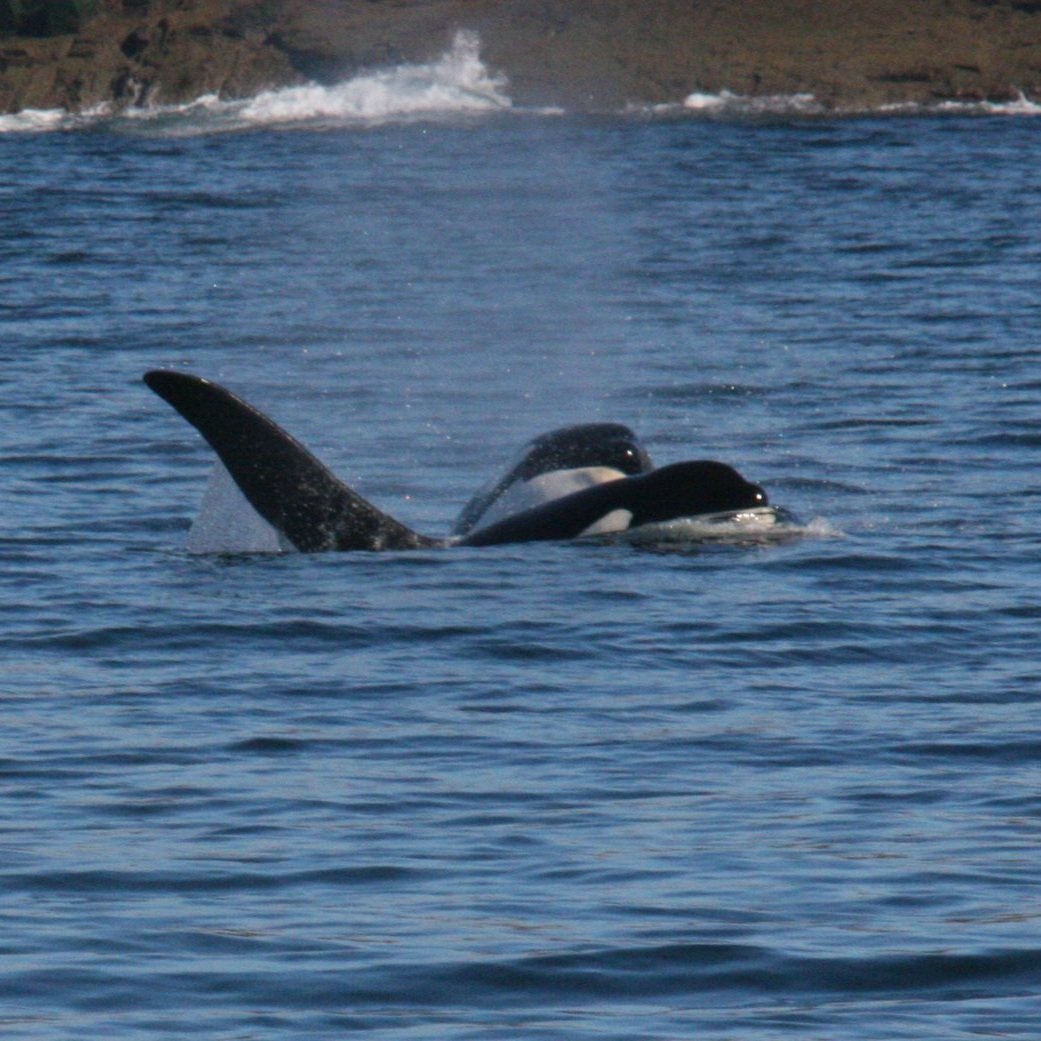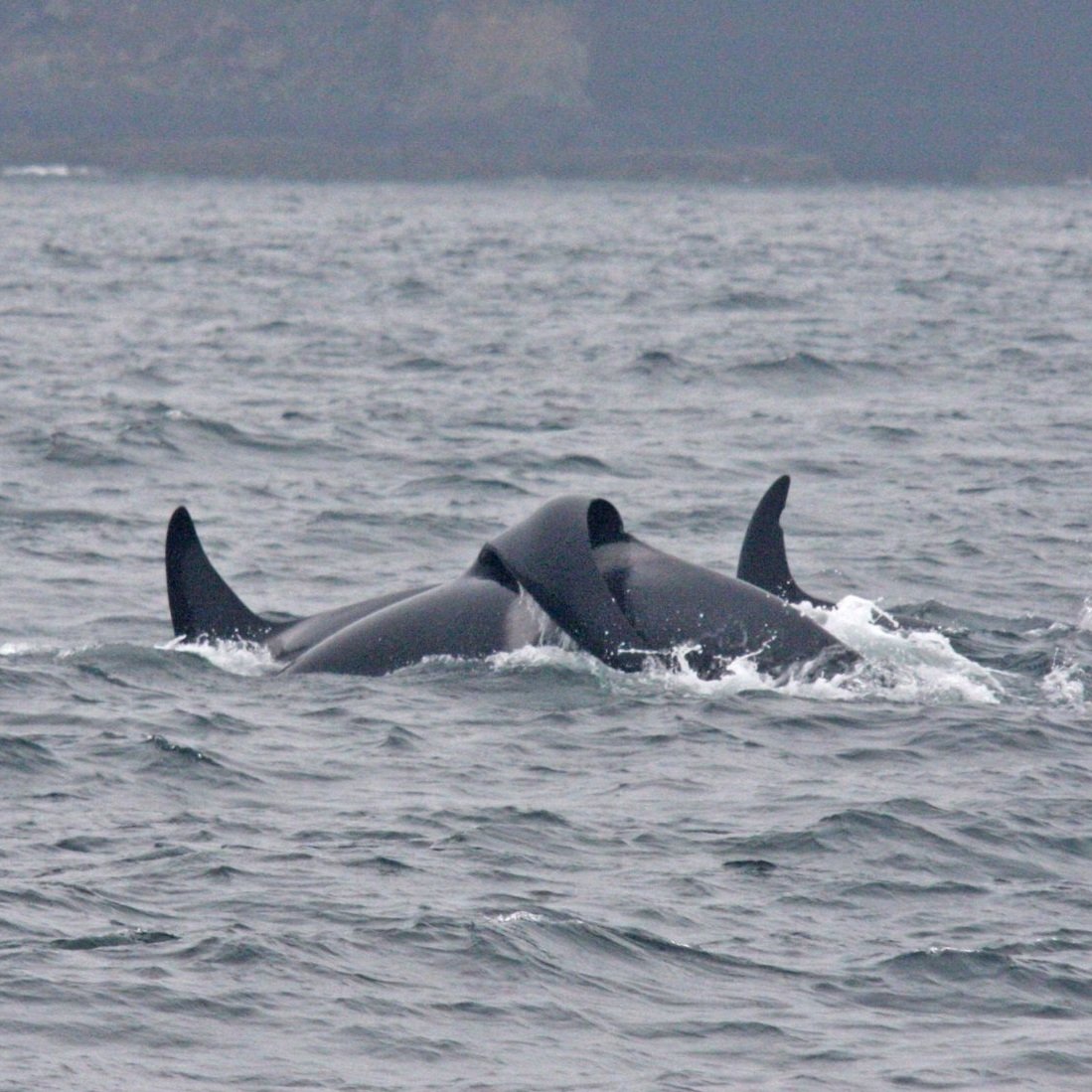Telling the tale of the west coast killer whale
John Coe and Aquarius of the West Coast Community, photographed during a research expedition in September 2023
Killer whales hold a special wonder for many people and in recent years, John Coe and Aquarius of the West Coast Community have become local celebrities. Morven, our Communications Manager, has followed the story of the plight of these killer whales for many years. Here she shares what has been uncovered about the group since she began working at the Trust…
When I moved to Hebrides in 2006, I had no idea that whales, dolphins and porpoises were found off Scottish coasts. After a few months volunteering with HWDT, I became aware of just how many species were recorded in the area. I can remember clear as day when a report came through that a killer whale had been seen preying on a porpoise off the west coast of Mull. I was captivated…the ocean’s predator right here in Scotland!
Back in 2006, very little was known about the West Coast Community, in fact Scottish killer whale populations were poorly understood. John Coe was already a recognisable individual – he’d ‘developed’ that distinctive dorsal fin by the time HWDT first documented him in the 90’s. It was thought that somewhere between 10 and 14 of these elusive killer whales were part of John Coe’s group - in those days their moniker ‘West Coast Community’ hadn’t been coined yet. They were known to ply the waters of the Hebrides and had occasionally been reported off Pembrokeshire, but that was the extent of the knowledge.
Then Dr Andy Foote began his research work - Dr Foote should be credited for laying the foundations of what we now understand about the killer whales found in Scottish waters. His research was both exciting and alarming – the West Coast Community (as he termed them) were a unique and highly vulnerable population.
Dr Foote discovered that the West Coast Community were unlike any other killer whale group in the north-eastern Atlantic. About a metre bigger with a distinctive eye patch orientation, their tooth wear was also a distinguishing feature – it is believed these predators hunt exclusively on other cetaceans and so display specific tooth wear which reflects their diet. Through the wider study of killer whales found off Scottish coasts, Dr Foote found that there didn’t seem to be any interaction between the West Coast Community and the Northern Isles Community (the name he used to describe the killer whales recorded off northern shores of Mainland Scotland, Orkney and Shetland). They were an isolated ecotype, more closely linked genetically to Antarctic whales than other populations in the area.
This female can be identified as a West Coast Community member due to her eye patch sloping downwards, as opposed to running parallel to her back
In 2008, one of the males of the group, thought to be Moon, washed ashore on Lewis. Although the remains were decomposed, the tooth wear was indicative of West Coast Community members. When the remains were examined, minke whale baleen was found in the animal’s stomach – which raised the question, did this group actively hunt larger cetaceans such as whales or did this individual just scavenge on a carcass? There is anecdotal evidence of killer whales surfacing either side of a minke whale in the Minch – but without proper documentation, we can never be sure.
Fast forward to 2016, a significant discovery was made…the lone killer whale bull who had swum up the River Foyle in 1977 was one of the West Coast Community! Comet was already a fully grown bull in the late 70’s, which aged him at around 60 years old – more evidence of just how old some of the individuals in the West Coast Community were.
Comet, photographed during a research expedition in September 2007
2016 also saw tragedy strike the West Coast Community. The last recorded female, Lulu, washed ashore dead on the Isle of Tiree. While the primary cause of death was determined as entanglement, analysis of her tissue showed Lulu to be the most toxic killer whale ever examined – with levels of polychlorinated biphenyls (PCBs) over 100 times the level at which they are known to affect the health of marine mammals. These toxic chemicals will have undoubtedly had an impact on Lulu’s ability to reproduce and, during her necropsy, it became apparent she had never produced a calf, despite being a mature female.
John Coe, Moneypenny and Lulu in 2014; one of the last times that Lulu was photographed alive.
While time is sadly running out for the West Coast Community, we are still adding to the knowledge base of these unique killer whales. 2021 marked the first time ever members have been recorded off English coasts – with John Coe and Aquarius sighted initially off Cornwall, then Dover a few weeks later. Later that year, during a monitoring expedition on board HWDTs research vessel, Silurian, vocalisations of John Coe and/or Aquarius were recorded – what we believe to be the first recordings of the West Coast Community ever made! These rare audio recordings were shared with the British Library last year, to be placed in their archives and preserved for future generations, alongside the sounds of extinct species and lost human languages.
The most recent research published in 2021 led by Dr Andy Foote revealed that the West Coast Community are a severely inbred population, likely inbreeding over several generations. With confirmed sightings of just two old bulls (John Coe and Aquarius) in recent years and no calves recorded since monitoring began, the authors of the paper conclude that inbreeding coupled with the social dynamics of the group, have further compounded their ability to sustain a healthy population.
While the story of the West Coast Community is ultimately a tragic one, we must try to learn as much as possible about the group before they disappear from our oceans. It’s vital that we understand the challenges species are facing so we can have healthier seas for all creatures. Much of what we know about the West Coast Community and the other killer whales off Scotland’s coast comes from the efforts of citizen scientists - people reporting what they’ve spotted. Thanks to these dedicated reporters, we know so much more about these awesome creatures.








